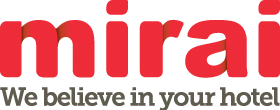En español, en français, em português.
Conversion rate has become a popular key metric for many hotels, and it is often included in executive reports and used to evaluate marketing directors or benchmarks across different hotels.
Vendors perceived this trend and invented the label “high conversion” for their products the same way Coca Cola made popular the “diet” label in the 80s. Every available product “boosts your conversion”, as if such a thing were easy. Is this obsession about conversion rate justified?
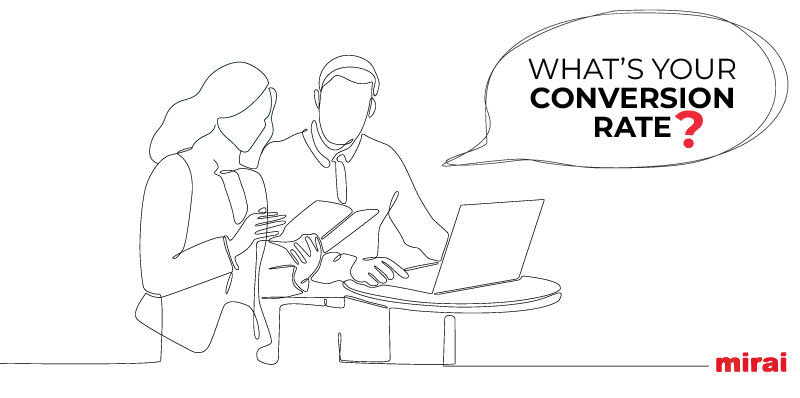
Should conversion rate be an objective?
Expectation about “conversion rate” makes sense and, undoubtedly, it is a KPI that is both helpful and worth monitoring over time as it shows you where you may be having problems and offers clues as to how to fix them. However, does conversion rate drive your business or impact your P&L?
I have never encountered a hotel that profits from its conversion rate. Hotels generate profit from revenue minus running costs. Everything that drives revenue is a KPI worth following, and revenue comes from reservations, but does conversion rate necessarily lead to revenue?
According to the formula, there is a direct relationship between the conversion rate, the visits, and the number of bookings.
Conversion rate = Reservations / Visits
This can be rewritten as:
Reservations = Conversion Rate x Visits
Mathematically speaking there is a direct relationship between conversion rate, visits, and the number of reservations, and the higher any of these numbers are, the more reservations will result. This is the true KPI that should be set as an objective, rather than conversion rate. We should also ask, are conversion rate and visits truly independent of each other? Can we increase one without affecting the other? If only it were that easy.
Conversion rate varies depending on your source of traffic
If you check your Google Analytics you will find important differences in conversion rate depending on the traffic source, and these differences are logical, as each source generates customers at different stages of the conversion funnel.
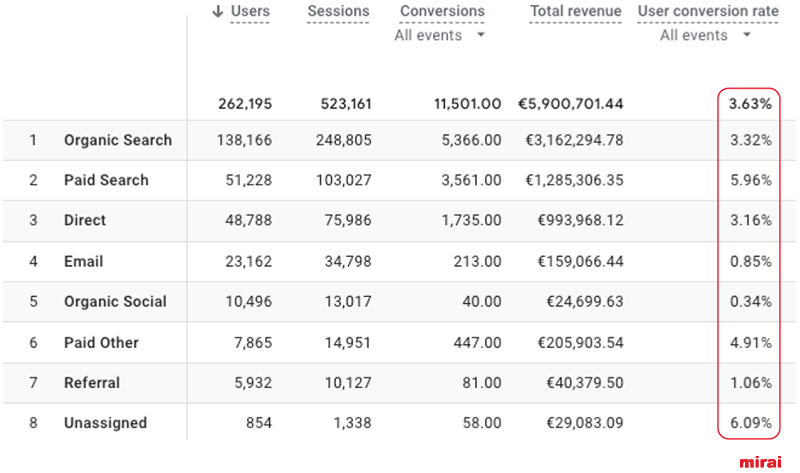
Ideally, we would want all traffic to convert at the maximum ratio, but unfortunately this is not an option; and remember, we should welcome any traffic that generates bookings, whatever the conversion rate. If this traffic bears a cost, obviously you’ll have to do the numbers to make sure it’s profitable, but if your strategy is to focus exclusively on the conversion rate, you’ll be tempted to get rid of your lowest conversion traffic, thereby losing bookings along the way as we can see in this simulation, where you would be tempted to stop running social media and email marketing campaigns and you would increase your conversion by 38% to 5.01% in exchange for losing €185,000 of revenue on the way though.
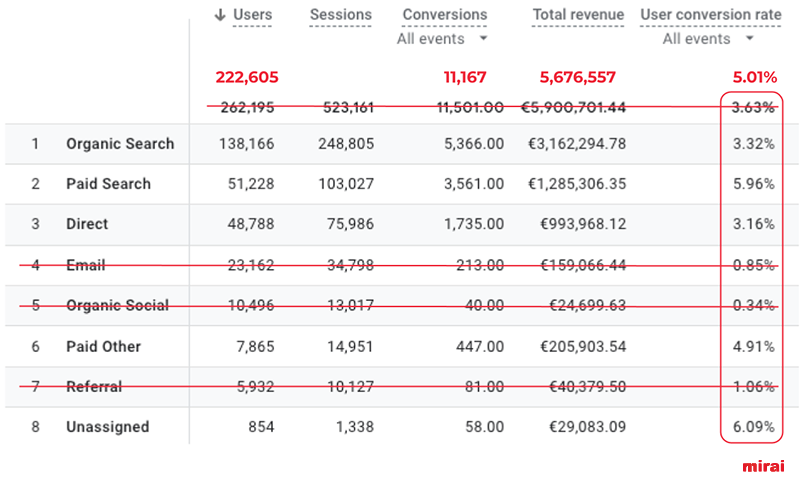
Does your hotel offer meeting rooms or a popular restaurant? Your conversion will struggle… and there’s nothing wrong with that
Some hotels offer more than just rooms for guests, such as restaurants, wedding venues and spas open to the public, and receive substantial traffic from customers interested in these services. As a result their conversion rate is impacted, as Google Analytics is normally configured to only consider hotel reservations as conversions, as we can see in this example:

If maximizing conversion rate were an objective, the temptation would be to close the restaurant in order to rapidly increase the same. Needless to say, this would be a terrible decision, resulting from an excessive focus on the conversion rate.

Better solutions would be to not consider this traffic when looking for your conversion rate, or to simply establish other goals for Google Analytics, such as table reservations or phone calls to the restaurant.
The fundamentals
As we’ve seen in the previous examples, conversion rate looks simple (reservations/visits). However, it is actually a far more complex and potentially misleading concept that is impacted by many variables. If you’re looking for a super-concise and efficient guide on how to boost your conversion rate, just try applying the following “basics”.
- Inventory. When you don’t have rooms to offer, your conversion rate is zero. It still happens that, in the high season, many hotels run out of inventory well before peak demand is reached. These hotels, therefore, have misleading low conversion rates, the result of good conversion rates when there is availability and zero when there is not.
- Pricing across channels. Allowing OTAs (especially Expedia and Booking.com) to undercut you severely harms your conversion rate and loyalty programs. However, using these channels incorrectly is the worst thing you can do to your direct channel and conversion rate. Additionally, and most importantly, never lose sight of what wholesalers such as Hotelbeds do with your rates. These are gateways to an opaque world where you never know the final price your customers will pay for your hotel.
Regardless of how excellent your technology (website and booking engine) is or how broad your marketing budget and skills are, if you don’t control the basics, your conversion rate will always struggle. Whenever conversion drops, however, most hoteliers’ favorite option is to replace their technology or marketing strategy. Curiously, they rarely blame their distribution strategy, as this would mean blaming themselves.
Maximizing your revenue, that should be your only objective
Since the number of bookings is the mathematical result of visits multiplied by conversion rate, let us identify the combinations that will increase this revenue.
The following table shows how revenue is impacted when visits and conversion rate change. Combinations with a green background will increase your revenue. It is worth noting that, even with a drop in conversion rate or visits, you can still increase revenue. Hotels that implement all strategies, forgetting about conversion, achieve the best results.
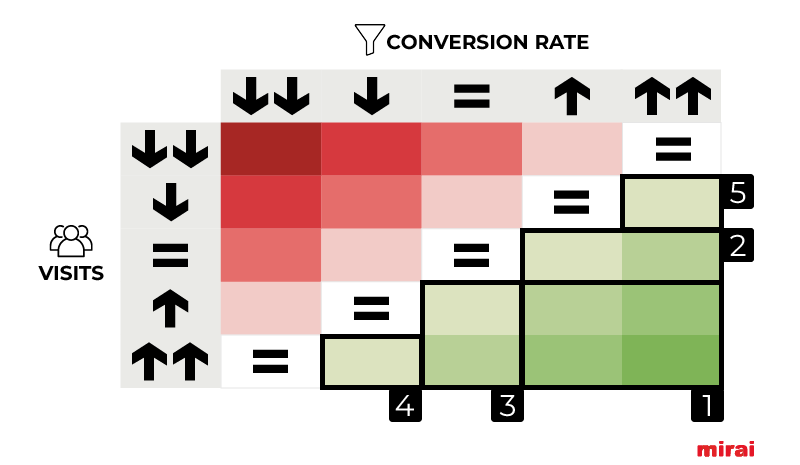
We review below the strategic actions of each combination. For ease of reading we have numbered them according to the quadrant.
[1] Increase your revenue by increasing both your conversion rate and visits
- Setting the right price compared to your competitive set will boost both your visibility (visits) and conversion rate. If your pricing is wrong, both numbers will drop.
- Improving your website’s usability and performance will help you convert more customers to reservations and better your site’s position in search engines like Google by attracting more visitors.
- Converting new customers to repeats will increase customer satisfaction. To achieve this you need the right loyalty program that will simultaneously drive repeat visits and increase your conversion rate.
- Driving high conversion traffic, mostly in the lower funnel, such as branded ads and metasearch (both paid and free, Google free booking links and Trivago’s equivalent).
[2] Increase your revenue by increasing your conversion rate without affecting your visits. The “basics” can be found in this category
- Increasing your room availability. If your customers cannot book, you will never generate bookings. Save more inventory for online and direct bookings, so when demand comes, you’ll be ready.
- Not allowing OTAs to undercut you. Your website struggles when OTAs offer better prices than you. The good news is that the solution is in your hands.
- Offering the most competitive rate to your customers. If you are determined to offer the best price directly, both your conversion rate and revenue will significantly increase.
- Differentiating your direct channel by means of exclusive advantages such as packages, extras, more payment options and more flexible cancellation policies. The more benefits you offer directly, the higher your conversion and revenue will be.
- Implementing a good booking engine. A cheap or poorly-designed booking engine is the worst decision you can make, as you will lose lots of bookings that will go directly to OTAs or, worse still, to your competitors.
[3] Increase your revenue by increasing your visits without affecting your conversion
- Increasing your online marketing budgets in the low funnel. By increasing these budgets they will access more demand and drive more bookings.
[4] Increase your revenue by increasing your visits and decreasing your conversion rate
- Bidding in the upper funnel where consumers are still in the planning stage and haven’t chosen a hotel yet. Here we find generic ads as well as upper-funnel strategies in metasearch such as Google Property Promotion Ads or Sponsored Placements in Tripadvisor. These new visits will generate new bookings, though your conversion rate will drop.
- Investing in search engine optimization or SEO. Non-branded keywords will bring you more visits and incremental bookings. However, it will kill your conversion rate.
- Email marketing campaigns to your customer database. While, depending on the content, email marketing can have a very high or very low conversion rate, it traditionally averages lower conversion rates compared to other traffic sources.
[5] Increase your revenue by increasing your conversion rate and decreasing your visits
- We cannot conceive of any reason to contemplate this scenario.
Conclusion
Although conversion rate is a very interesting and meaningful KPI, hotels should only use it to make comparisons over time, and always properly segmented by source of traffic, device and market. Conversion rate should never be used for the sake of comparison with other hotels or with your presumed conversion rate in OTAs.
What really matters is the revenue generated by your direct channel, and the percentage of your total this revenue represents. These are the true KPIs you should always keep a close eye on.



